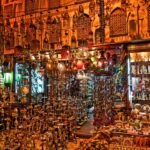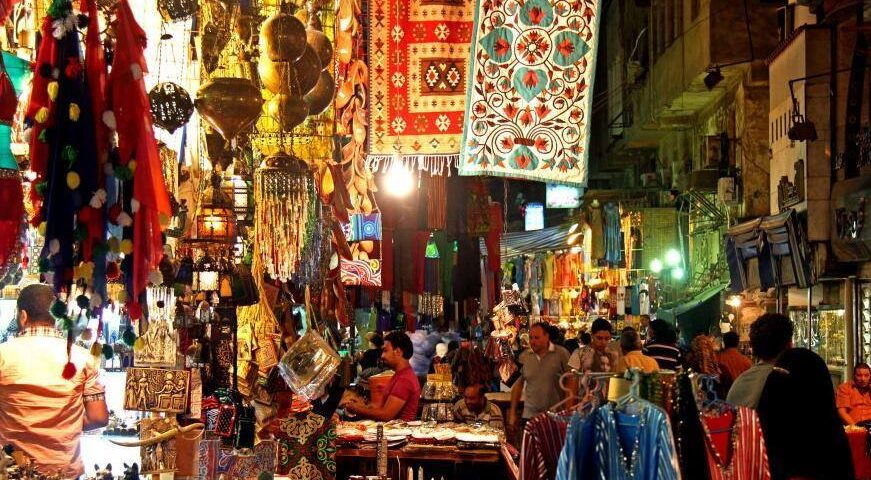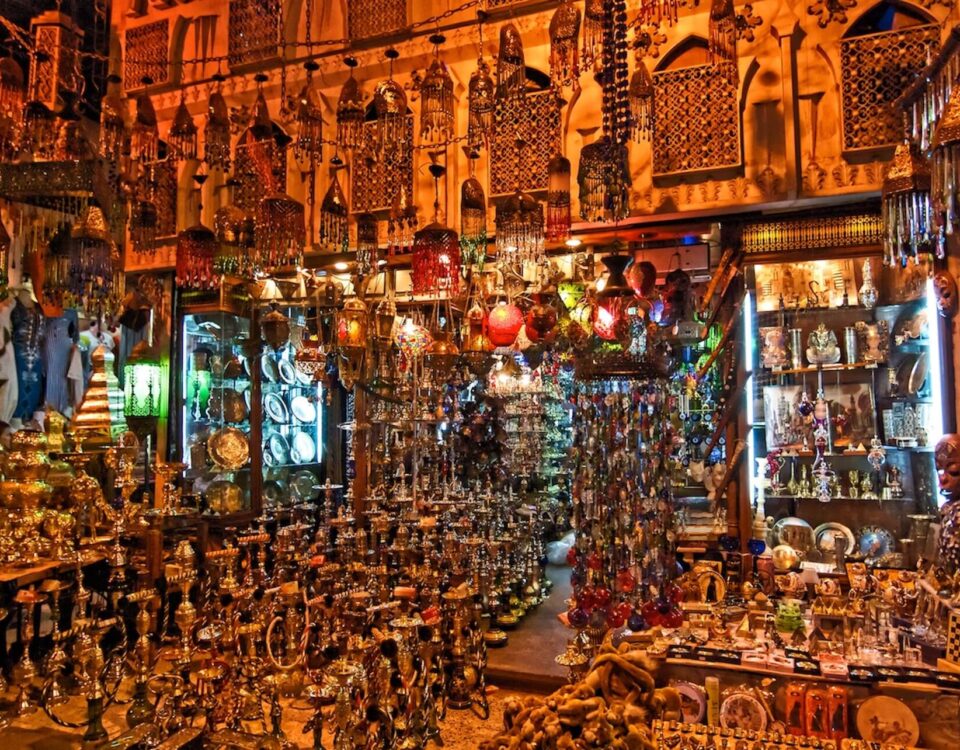
Khan el-Khalili for Photographers: Capturing Cairo’s Timeless Market
November 5, 2025
Ideal Time to Visit the Khan El Khalili Bazaar
November 6, 2025Nestled in the heart of Cairo’s historic Islamic district, Khan el-Khalili stands as one of Egypt’s most iconic bazaars, drawing millions of visitors each year. If you’re planning a trip to Cairo and pondering the question, “is Khan el Khalili worth visiting,” you’re not alone. This vibrant souk, with its labyrinth of alleys filled with colorful stalls, aromatic spices, and ancient architecture, offers an immersive dive into Egyptian culture. In this comprehensive guide, we’ll explore its history, what to expect, pros and cons, real traveler reviews, and insider tips from locals to help you decide if this legendary market deserves a spot on your itinerary.
Whether you’re a history buff, a bargain hunter, or simply seeking an authentic taste of Cairo life, Khan el-Khalili promises an unforgettable experience. Let’s delve into why so many travelers rave about it—and why some advise caution.
A Brief History of Khan el-Khalili: From Medieval Trade Hub to Modern Icon
To truly appreciate whether Khan el Khalili is worth visiting, it’s essential to understand its rich backstory. Established in 1382 during the Mamluk era by Emir Djaharks el-Khalili, the bazaar was originally built as a caravanserai—a resting place for merchants and traders along ancient trade routes. The site itself holds even deeper historical significance, sitting atop the ruins of a Fatimid palace and a former royal mausoleum known as Turbat az-Za’faraan (the Saffron Tomb).
Over the centuries, Khan el-Khalili evolved into a bustling center of commerce, attracting traders from across the Middle East, Africa, and beyond. During the Ottoman period, it continued to thrive, with Turkish merchants inhabiting structures like the Wikala al-Qutn. Today, it’s recognized as a UNESCO World Heritage site within Islamic Cairo, blending medieval architecture with contemporary vibrancy. The market’s narrow streets and ornate gates, such as Bab al-Badistan, echo tales of spice routes, silk trades, and cultural exchanges that shaped Egypt’s identity.
This historical depth adds a layer of intrigue that goes beyond shopping—it’s like stepping into a living museum where every corner tells a story.
What to Expect When Visiting Khan el-Khalili: A Sensory Overload
Imagine winding through cobblestone alleys lined with shops overflowing with handmade lanterns, intricate jewelry, fragrant spices, and traditional textiles. That’s the essence of Khan el-Khalili. As one of Cairo’s oldest souks, it spans a vast area integrated into surrounding neighborhoods like al-Muski street, which functions as an extension of the market frequented by locals.
Visitors can browse for authentic Egyptian souvenirs such as blown glass, brassware, perfumes, scarves, and even Egyptian costumes. Artisan workshops showcase traditional crafts, from coppersmiths hammering pots to jewelers crafting intricate pieces. Don’t miss the nearby landmarks, including the Al-Hussein Mosque and the historic El Fishawy cafe, one of the oldest in the Middle East, where you can sip mint tea or karkade (hibiscus tea) while people-watching.
The atmosphere is electric: vendors calling out deals, the scent of essential oils mingling with street food like roasted peanuts or sweet potatoes, and the glow of colorful lamps illuminating the scene at night. It’s a place where history meets hustle, making it a must for anyone asking if Khan el Khalili is worth visiting.
Pros and Cons: Is the Hype Justified?
Like any popular attraction, Khan el-Khalili has its highs and lows. Here’s a balanced look:
Pros:
- Cultural Immersion: It’s a gateway to authentic Egyptian life, with locals shopping alongside tourists. The blend of history, architecture, and daily commerce is unparalleled.
- Shopping Variety: From high-quality artisan goods like jewelry and textiles to affordable spices and lamps, there’s something for every budget.
- Atmospheric Experience: Especially magical at night during Ramadan, when lanterns light up the alleys.
- Accessibility: Free to enter, and located near other Cairo highlights like the Citadel.
Cons:
- Crowds and Chaos: The market can be overwhelming, with persistent vendors and narrow paths.
- Haggling Pressure: Prices are often inflated; bargaining is expected, which can be tiring for some.
- Safety Concerns: Pickpocketing is a risk in busy areas, and beggars are common.
- Heat and Timing: Avoid midday visits in summer due to intense sun.
Overall, the pros outweigh the cons for most, but it depends on your tolerance for bustling environments.
Honest Traveler Reviews: What Visitors Really Think
Drawing from platforms like Tripadvisor and Reddit, traveler feedback is overwhelmingly positive, with many declaring Khan el Khalili a highlight of their Cairo trip.
One reviewer on Tripadvisor called it “a wonderful market and an absolute must-visit,” praising the “narrow lanes, winding alleyways, and vibrant energy.” Another shared, “Diving into the soul of Cairo – the scents of spices and coffee make for total sensory immersion.”
On Reddit, a solo female traveler noted, “Walking around Khan el Khalili was fine… I dressed conservatively and had no issues.” Families appreciate it too: “I took my 5-year-old twins, and it was great for children.”
Critics mention the haggling: “Be prepared to negotiate; initial prices are often triple.” And safety: “Busy bustling market… be aware of your belongings.” Yet, even skeptics often conclude it’s worth it for the charm.
Local Insights: Beyond the Tourist Facade
Locals view Khan el-Khalili as more than a tourist spot—it’s a daily hub for Egyptians. “Most of Khan El Khalili’s patrons are Egyptian locals, so the market is bustling at almost all hours,” shares one Cairo resident. They shop for household items, spices, and even Mo Salah-themed Ramadan lanterns, blending tradition with modernity.
Artisans emphasize craftsmanship: “You’ll see locals engaging in animated conversations over tea in ahwas (coffeehouses).” For better deals, head to quieter alleys off the main paths, where vendors are less pushy. Locals advise visiting during evenings for a lively yet cooler vibe.
Essential Tips for Your Visit to Khan el-Khalili
To make the most of your trip:
- Bargain Smartly: Start at half the asking price and walk away if needed—vendors often call you back.
- Best Time: Early morning or evening to avoid crowds and heat. Ramadan adds extra magic.
- Safety First: Keep valuables secure, use reliable taxis, and dress modestly.
- What to Buy: Opt for artisan goods like brassware or jewelry for authenticity.
- Getting There: Take a taxi or Uber to Al-Hussein Square; it’s central and easy to navigate.
FAQs About Khan el-Khalili
Is Khan el Khalili safe for solo travelers?
Yes, but stay vigilant against pickpockets and avoid isolated areas at night.
What is the best time to visit Khan el Khalili?
Evenings or early mornings; avoid midday in summer.
How much time should I allocate for a visit?
2-4 hours to explore shops, cafes, and nearby mosques.
Is bargaining necessary at Khan el Khalili?
Absolutely—it’s part of the culture and can save you up to 50%.
Are there guided tours available?
Yes, many tours include Khan el-Khalili for a hassle-free experience.
Final Words
So, is Khan el Khalili worth visiting? Absolutely yes—for the cultural immersion, historical allure, and vibrant energy that capture the soul of Cairo. While it may not suit those who dislike crowds or haggling, its unique blend of past and present makes it an essential stop for most travelers. As one local aptly puts it, “Khan El Khalili encapsulates the essence of Cairo—vibrant, historic, and forever alive with tales.” Plan wisely, embrace the chaos, and you’ll leave with memories (and souvenirs) that last a lifetime.


